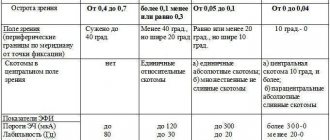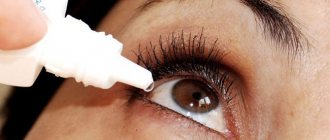Laws that regulate visual impairment
A type of such disability can be assigned to citizens of the Russian Federation who have a complete loss of vision, or its partial impairment, which prevents them from fully engaging in work activities and everyday household chores.
It is possible to maintain the lifestyle of a full-fledged person with visual impairment only in isolated cases. Even if no other pathologies of the body are noted, a person cannot function normally without seeing partially or completely the picture around him.
Today, visual impairment is regulated by the following legislative laws:
- Resolution of the Ministry of Health , which clearly defines the conditions for obtaining visual disability and the procedure for payments made;
- Federal Law No. 46 – defines the rights of people with limited vision;
- Federal Law No. 181 - provides for social protection provisions and benefits for people with disabilities.
Curvature and cloudiness of the lens
Federal benefits for the visually impaired
According to Government Order No. 2347-r dated December 30, 2005 (as amended in 2017), a list of activities, services and technical services has been determined at the federal level. rehabilitation funds provided to disabled people.
| Some rehabilitation measures from the list | Those. means according to the applicable list | Services from the federal list |
| Therapy, surgery with the provision of necessary medications; sanatorium and resort treatment as part of the NSU; prosthetics; comprehensive medical rehabilitation, including orthotics | Appropriate devices for reading "talking books"; optics for low vision correction; thermometers and tonometers with speech output; dog - guide with equipment; support (tactile) canes, supports, etc. | Repair of failed used equipment. funds; services for language translation (with simultaneous hearing and vision impairment); compensation for the maintenance of a guide dog and for veterinary services |
In addition to the listed social support measures, all federal beneficiaries (including the visually impaired) are entitled to: EDV. NSU, disability pensions.
Visual disability - criteria
According to statistical data for Russia, every year about fifty-five thousand citizens (both children and pensioners) are assigned a certain disability group for visual impairment.
This indicator includes deviations ranging from minor visual impairment to significant loss of sensitivity to light and complete inability to see.
To assign a disability group to a person, medical institutions evaluate visual acuity and the person’s ability to care for himself independently.
The latter indicator includes:
- Movement in space without the help of strangers;
- Possible unhindered communication;
- Ability to learn;
- Ability to control behavior;
- Unobstructed orientation in the environment;
- Ability to work independently.
These criteria can be expressed in different degrees, hindering a person’s independent abilities, lowering the quality of life and lowering its level.
The more pronounced the violations, the more discomfort it will cause in everyday life.
Depending on the severity of the impairment, one or another group of visual disability is assigned. To accurately determine the group, all indicators of visual impairment are assessed.
An important fact is that visual acuity abnormalities can affect both eyes, but with varying degrees of severity.
Assessing a person’s condition in a specialized medical institution, the commission evaluates visual impairment precisely according to the condition of the healthiest eye, determining in what cases and to what extent the quality and limitations of everyday life are impaired.
The main criteria for each degree of severity are approved in the ICD and consist of:
- Ability to work with visual impairment;
- Acuity index and field of view assessment;
- Basic coefficients of electrophysiological indicators.
| Vision function | Degree of visibility impairment | |||
| One eye, or the one that sees better after correction | 1st degree. Minor (small loss of visibility) | 2nd degree. Moderate (moderate vision loss) | 3rd degree. Severe (significant vision loss) | 4th degree. Extremely severe (virtual or complete blindness) |
| What degrees of vision are assigned to (acuity) | 0,4 – 0,7 | Greater than 0.1 but less than 0.3 (or equal to 0.3) | 0,05 – 0,1 | 0 – 0,04 |
| Field of visibility (borders along the meridian from the fixation point) | Narrowed to 40 degrees | Less than 40 but more than 20 degrees | Less than or equal to 20 but wider than 10 degrees | From 10 to 0 degrees |
| Scotomas in the central field of view | None | Single relative scotomas | Single absolute or multiple non-confluent scotomas | Central scotoma of 10 degrees or more, as well as paracentral absolute confluent scotomas |
| Electrophysical indicators: EC thresholds (µA) Lability (Hz) CNSM (Hz) | <80 <45 | <120 <30 <30 | <300 <20 <20 | >300 <20 <20 |
| Ability to see | Absent | Moderate decline | A pronounced decrease | Significantly pronounced decrease or complete absence |
For what type of vision is disability given in Russia?
The factors by which it is possible to assign a disability group are assessed by qualified ophthalmologists, determining the degree of vision damage. The assessment is made based on legislation and other important factors.
In total, there are 3 disability groups assigned for visual impairment:
1 group
It is determined in patients who have severe damage to the nerves of the visual system that cannot be restored.
The loss of visibility in this case amounts to more than eighty-five percent of the perception of the environment and lifelong blindness is achieved.
The first group is diagnosed if the patient has a fourth degree of visual impairment, in accordance with the above table.
With such disorders, there are significant deviations in the functionality of visibility (absolute and complete blindness) and a decrease in vital activity to the third degree.
In this state, a person cannot carry out everyday life processes without assistance from social protection.
2nd group
Assigned only when a person has severe impairments in the functioning of the visual analyzer of the third degree (significant visual impairment), with a concomitant lowering of life criteria to the second degree.
Having such conditions, a person needs social protection to help with everyday life.
3 group
Assigned only if the second or first degree of impairment of the functions of the visual organs is registered. In this condition, slight impairments in visual functionality are observed (moderate loss of vision).
Also, the category of vital activity is reduced to the second degree. When a person is partially unable to care for himself, but needs social assistance.
When assigning a disability group, qualified doctors examine not only visual impairments, but also pathological conditions recorded in the medical record, general health, location of residence, environmental properties and age category of the patient.
Also, the level of material security and social status of a person can become important factors.
Payment amount
Regardless of the disability group, people belong to vulnerable segments of the population that need financial assistance from the state.
The size of the payment directly depends on the group; the table will give more details about the payments themselves.
| Disability group | Payment amount | One-time payment if services are refused | If you have not canceled the service package |
| The first group is a disabled child and persons who received a disability upon reaching the age of eighteen | 12,500 rubles | 36 27 rubles | 2,590 rubles |
| Disabled children of the second group and disabled people of the first group | 10,400 rubles | 3,627 rubles | 2,590 rubles |
| Disabled people 2nd group | 5,200 rubles | 2,590 rubles | 1,730 rubles |
| Disabled people of 3 groups | 4,500 rubles | 2,073 rubles | 1,250 rubles |
Disabled people receive these payments if they do not meet the requirements for the assignment of a labor pension.
How to register for visual disability?
In order to register a disability correctly and without any problems, you need to follow a certain algorithm of actions.
Registration of disability is not a simple matter, but by observing all the points of the algorithm below, you can avoid misunderstandings and miscalculations.
- If a person has a severe visual deviation that interferes with daily self-care and life activities, it is necessary to undergo an examination by a qualified ophthalmologist, who can be found in the hospital where he lives. After the doctor conducts an examination, he will prescribe treatment that is aimed at eliminating symptoms and restoring normal vision. If after a person undergoes a course of therapy, no improvement is observed, you can ask the doctor for a referral to an ITU that determines the disability group.
To assign a minimum (third) disability group for visual impairment, its impairment must be less than 0.1.
- After the doctor issues a referral for an examination, you will have to undergo it, even if no other pathologies are noted. If other pathologies or complications are noted during the examination, additional laboratory and hardware tests may be performed;
- After passing the examination, you need to go with the results to the doctor who referred the patient for research. Next, the doctor draws up a conclusion, which must be certified by the head physician. At the end of the outpatient examination, the doctor refers the patient to MSE;
- Next, you need to collect your documents and those issued at the clinic, and go to the regional ITU center. The list of required documents includes:
- Disease history;
- Originals and copies of extracts from the clinic where the course of treatment was carried out;
- A photocopy of the work record book (must be certified by a notary);
- Application for examination;
- Original and photocopy of passport;
- Referral by the attending physician to medical examination;
- If available, then an act of injury at work or an occupational disease is required.
- Attend a meeting of the commission, where an opinion is given on the group of destination, or refusal in the group of visual impairment.
Based on all the documents, the commission can issue two types of disability for visual impairment, which are shown in the table below.
| Variety | Characteristic |
| Temporary assignment of disability | Assigned for a certain period, after the expiration of which, a re-examination is required. |
| Permanent assignment of disability | Assigned for life, no additional examinations are required. |
Permanent visual disability of the first category is assigned to those citizens who have the following factors:
- Diagnosed complete loss of vision in both eyes;
- Decline (minus) of vision in both eyes is less than 0.3;
- The patient's condition did not improve after a course of therapy and surgery;
- Narrowing of the visual field of both eyes to ten degrees or less (keratoconus), which is characterized by pathological diseases that cannot be reversed.
Examination by an ophthalmologist
What is the pension for visually impaired people of groups 1, 2, 3 in 2021
According to statistics from the World Health Organization, there are about 300,000 million people in our country who suffer from complete or partial blindness. However, one in four people have vision problems that can be corrected with glasses or contact lenses.
Becoming visually disabled is quite a serious process, but after receiving the status, the citizen will have many benefits, and most importantly, the right to receive pension payments. As part of this article, we will talk about visual disability, as well as what a disabled person of groups 1, 2 or 3 can qualify for in 2021.
Who is given a visual disability?
Only those citizens who have deviations from the norm, in this case features related to visual functions, are recognized as disabled. When assigning disability, a group is determined that determines the degree of the disease and the amount of payments and benefits provided in the future.
| Disability group | Who should | Peculiarities |
| First group | The most severe group is assigned only to those citizens who have a 4th degree deviation. It is impossible to work with the first group, since often a person cannot even take care of himself. | Complete blindness, which is characterized by: 1. Visual acuity up to 0.04 diopters;2. Narrow field of view. |
| Second group | Violation of the visual channel. It is possible to carry out labor activities, but this requires specialized equipment. Important! It is strictly forbidden to take a job in those places where it is necessary to carry out a quick visual check (parts, tools, food), which a disabled person cannot cope with. | The limit of vision is from 10 to 200 from the point where the gaze stopped. In addition, visual acuity is not less than 0.5 diopters. |
| Third group | Perhaps the easiest, if you can call it that. The degree of violation corresponds to group two. Employment is possible in any organization where there are quota places intended for people with disabilities. | The boundaries of both eyes vary from 20 to 400 from gaze stop. The acuity does not exceed 0.3 diopters. |
If we talk about the percentage of the disorder, then:
- The first is from 90 to 100%, respectively, complete absence of vision;
- The second is 70-80%, which is the ability to take care of yourself;
- Third – the rate is above 40% and up to 60%.
| The main reasons that influence the complete or partial loss of visual function | ||
| № | Cause | Explanation |
| 1 | Congenital disease | Those diseases associated with vision that are acquired at birth. Unfortunately, children are also born with blindness or a disorder caused during childbirth. |
| 2 | Aged people | At risk are also older people who, due to circumstances, cannot or do not want to visit a specialist, thereby triggering their condition. Important! If a person cannot come to an ophthalmologist on his own, he can be called to his home. |
| 3 | Injuries | Often, vision loss occurs due to the herbs received either during work or in an accident. |
| 4 | Presence of disease | There are diseases that provoke the worsening of existing vision problems. These include: 1. Myopia;2. Cataract;3. Diabetes mellitus;4. Keratitis;5. Retinal burns;6. Glaucoma;7. Excess weight. |
| 5 | Wrong lifestyle | The point can be explained from the following angles: v Poor environment in which a person lives; v Lack of vitamins and minerals that are necessary for vision; v The introduction of gadgets into our lives, watching TV around the clock. |
In order to be assigned a visual disability, a person must meet the following requirements:
- It needs both financial assistance from the state and restoration through rehabilitation measures;
- A person cannot perform normal functions independently and without additional equipment.
Important! The assignment of disability and the corresponding group is carried out only by a medical and social examination (MSE).
Necessary documents for registration
To apply for disability, regardless of the disease, you need to have documents that confirm not only the identity of the person who submitted the application, but also the disease itself.
Required documents include:
- A statement written in the disabled person’s own hand. If this is not possible, a representative can also write an application;
- Identity document;
- Referral for examination, which can be taken to:
- clinics at your place of residence, namely from an ophthalmologist;
- Pension Fund of the Russian Federation;
- social protection.
- If a person carries out labor activity, then it is necessary to have:
- work book
- income certificate;
- characteristics.
- Medical documents that characterize the treatment performed in a hospital setting, and also reflect ambulance calls, if any;
- Rehabilitation program;
- If a person previously had a disability, then a certificate indicating this is needed.
Only after providing these documents, the person will be examined.
Step-by-step instructions for registration
The entire process of registering disability can be divided into stages that are not complicated, but nevertheless take time and questions arise.
To register a disability you must:
- Receive a referral for examination;
- Collect the necessary documents;
- Pass the commission on the date and time appointed by the specialist;
- Receive a decision, which can be: Positive - in this case, forensic medical experts will issue a state-issued certificate, which contains the data of the disabled person and his group.
- Negative decision - in this case, it is necessary to determine the reason for this decision. If a person is confident that he is right, he can go to court to appeal the decision.
Payment amount
Regardless of the disability group, people belong to vulnerable segments of the population that need financial assistance from the state.
The size of the payment directly depends on the group; the table will give more details about the payments themselves.
| Disability group | Payment amount | One-time payment if services are refused | If you have not canceled the service package |
| The first group is a disabled child and persons who received a disability upon reaching the age of eighteen | 12,500 rubles | 36 27 rubles | 2,590 rubles |
| Disabled children of the second group and disabled people of the first group | 10,400 rubles | 3,627 rubles | 2,590 rubles |
| Disabled people 2nd group | 5,200 rubles | 2,590 rubles | 1,730 rubles |
| Disabled people of 3 groups | 4,500 rubles | 2,073 rubles | 1,250 rubles |
Disabled people receive these payments if they do not meet the requirements for the assignment of a labor pension.
Other benefits
The benefit depends directly on the assigned disability group; below in the table only general benefits will be indicated.
| Benefits for the visually impaired | ||
| № | Type of benefits | What does it include |
| 1 | Social | v Monthly payment, called a pension, depending on the disability group. Important! The monthly payment should not be less than the established subsistence level. If a disabled person does not have enough money before him, then the missing amount is added by the social protection authorities.v Obtaining education;v Obtaining EDV;v Discount on payment of state fees: Ø 100% discount on payment of fees in court; Ø 50% of the total amount of payment for notary services. |
| 2 | Transport | v Payment for travel. v Transportation to the place of treatment |
| 3 | Tax | v Transport; v Property; v Land; v Tax deductionsImportant! If there are several taxable objects, the discount is provided only for one type of transport or real estate. |
| 4 | Medical | v Free receipt of medications that a person needs;v Once a year, provision of sanatorium-resort treatment that will have a positive effect on the disease;v Additional products (orthopedic shoes, prosthetics;v Necessary rehabilitation. |
| 5 | Housing | v Discount on payment of utilities:Ø Electricity;Ø Water (hot and cold);Ø Heating.v housing;v Major repairs;v If a disabled person lives in conditions that do not meet sanitary standards, the amount of the norm for each person |
| 6 | Labor, take place in the case when the assignment of a group does not interfere with official employment | v Shortened working day - only 35 hours; Important! Part-time work does not affect pay and the amount of leave.v The right to refuse to carry out labor activities outside of working hours, weekends or holidays;v Additional days off in the amount of 4 days, which are paid as working daysImportant! The benefit for additional days applies to one parent.v The right to choose the date of leave;v Additional leave in the amount of two weeks without pay. |
Expert opinion
Unfortunately, most people who have reduced visual activity and complete blindness received this diagnosis more than once. This means that at first the first signs of deterioration were observed, to which the patient did not pay attention and did not go to a specialist for help.
Worse, the person began to see poorly and decided to take up treatment on his own and drip drugs of unknown content into his eyes, which is strictly prohibited.
As an ophthalmologist with 46 years of experience, I say that patients come to me mainly aged from 40 to 80 years, with whom I have a dialogue like this:
- Doctor: What were you treated with?
- Patient: Dripped “and names the medicine”;
- Doctor: Who prescribed this to you?
- Patient: Nobody, it helped my neighbor.
And then I, being in shock, say that this medicine will not have any effect on the disease in this case. This is a pretty scary situation, so if you notice:
- Deterioration in clarity (if previously you could recognize a person at a distance of 3-4 meters, now facial features are blurred);
- It is impossible to read (the letters have become blurry or cannot be seen at all;
- Myopia (you can’t cross the road because you can’t see the car).
If several points converge, you need to consult a doctor; in the early stages, you can correct your vision by prescribing the right medications, choosing glasses, and in extreme cases, using surgery. Over time, the opportunity to restore vision is lost, so you should pay attention to your health when it hints at it.
Chief ophthalmologist of Russia, Doctor of Medical Sciences, Professor Neroev V.V.
Common Questions
Question No. 1 I received a visual disability of the second group 4 years ago, but unfortunately the medical and social examination did not assign me a group indefinitely, but only for a year with subsequent re-registration.
Accordingly, I have been involved in renewals almost 4 times already, the examination itself is located in the city, but I live in a village and it is too far for me to get to the point.
What is the maximum number of years they can assign me to a group per year?
Answer: To make a decision on the medical and social examination, the possibility of recovery is also taken into account. That is why the group is assigned for one year with an extension, since the person can recover during this time.
Regarding difficulties in travel, there is also the possibility of calling a commission to your home, which will conduct a survey and inspection and make a decision. To call the commission, you should contact the medical and social examination itself, which will set a date for the visit.
As for disability, if within 10 years a disability is assigned for up to one year, then for the 11th year the commission will establish a permanent group.
Important! If within 10 years the disability was canceled and then reassigned (with the exception of a court decision), then the above rule will not apply.
Question No. 2 Are the criteria for registering the disability of a child and an adult the same? And what group will the child be assigned to?
Answer: Yes, the criteria are the same. However, the disability group is not established; the child receives the status of a disabled child, which requires re-registration after 18 years of age with the subsequent assignment of a disabled child with a certain group.
Common mistakes
Error A citizen, having received a referral from a clinic at his place of residence, was refused to be assigned a visual disability.
Source: https://pravo-invalida.ru/pensiya-i-doplaty-invalidam-po-zreniyu-1-2-3-gruppy-v-2019-godu/
How to behave in case of refusal?
When the expert commission considers the issue of assigning a visual disability group, a refusal may be made. If a citizen does not agree with the decision made, he can legally appeal the decision. Also, an appeal against the determined disability group can be made.
The peculiarity is noted when filing an application for appeal. If the disability determination was made at the bureau, an appeal is possible only by contacting the main bureau. And if the resolution was in the main bureau, only in the federal bureau.
Registration must be made no more than one month from the date of the initial decision.
In the event of a repeated refusal or incorrect assignment of a disability group, a court hearing will help make a decision.
Benefits and pension amount
People with a confirmed disability group due to visual impairment (loss) are assigned the right to create a recovery plan on an individual basis, including the acquisition of the necessary devices to maintain normal life functions.
Such a program necessarily includes medication, psychological, social protection, economic and social assistance.
Citizens of Russia who have been assigned a visual disability group are assigned a pension (at the appropriate age) in the amount of:
- The first group (from birth) and children with disabilities – 11,650 rubles per month;
- Second group (from birth) and acquired first group – 9840 rubles per month;
- The second group, acquired from childhood during life - 4320 rubles per month;
- Third group – 4150 rubles per month.
A visually disabled person is entitled to monthly cash payments.
In addition to pensions, there are also cash payments that are made every month for visually disabled citizens who are not of retirement age:
| Group | Number of payments (rubles) |
| 1 | 3240 |
| 2 | 2340 |
| 3 | 1820 |
| Child with a disability | 2190 |
To calculate payments, they take into account living conditions, environmental factors and the reason why a person will lose the ability to see. Due to these factors, final payments may increase.
Other benefits
The benefit depends directly on the assigned disability group; below in the table only general benefits will be indicated.
| Benefits for the visually impaired | ||
| № | Type of benefits | What does it include |
| 1 | Social | v A monthly payment, called a pension, depending on the disability group.
v Getting an education; v Receiving EDV; v Discount on payment of state duty: Ø 100% discount on payment of fees in court; Ø 50% of the total amount payment for notary services. |
| 2 | Transport | v By payment for travel. v Transportation to the treatment site |
| 3 | Tax | v Transport; v Property; v Land; v Tax deductions
|
| 4 | Medical | v Free receipt of medicines that a person needs; v Once a year, provision of spa treatment that will have a positive effect on the disease; v Additional products (orthopedic shoes, prosthetics; v Necessary rehabilitation. |
| 5 | Housing | v Discount on utility bills: Ø Electricity; Ø Water (hot and cold); Ø Heating. v Housing maintenance; v Major repairs; v If a disabled person lives in conditions that do not meet sanitary standards, the amount of the norm for each person |
| 6 | Labor, take place in the case when the assignment of a group does not interfere with official employment | v Shortened working day - only 35 hours;
v The right to refuse to carry out labor activities outside of working hours, weekends or holidays; v Additional days off in the amount of 4 days, which are paid as working days
v The right to choose the date of vacation; v Additional leave of two weeks without pay. |











